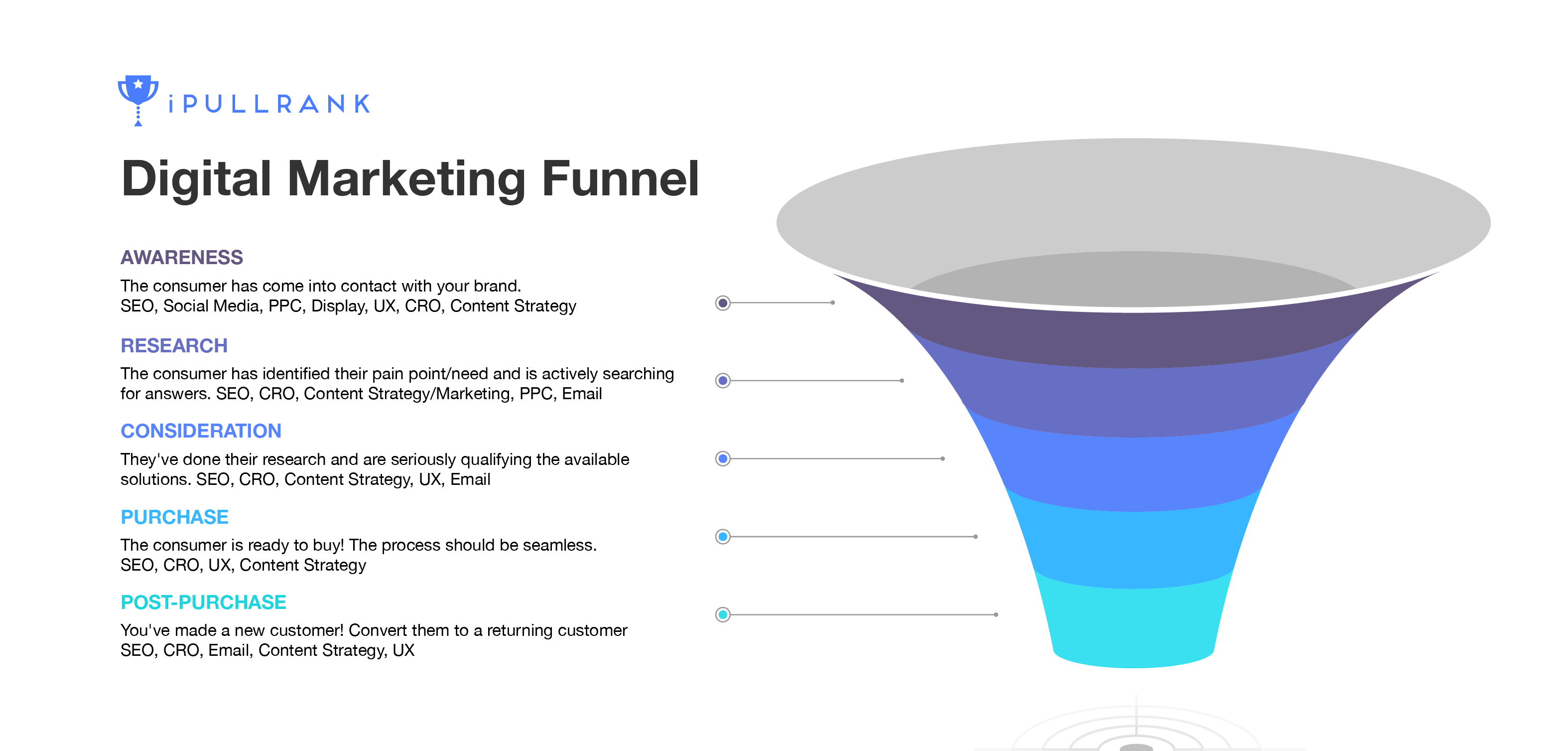From large corporations to small and medium companies, many fall victim to ignoring effective fundamentals of modern digital marketing. Whether it’s from a lack of skilled talent, or a lack of time and agility, businesses often fall short of their goals due to a limited understanding of the audience. So identifying what customers want is an essential initial step for every marketing strategy.
The customer is at the heart of any and all marketing efforts, and in digital marketing there is a wealth of information to support that. Ask any seasoned marketing expert and they will tell you that the buyer’s journey should be at the foundation of every single marketing plan. Still not convinced? Let’s look at some facts:
- “By 2020, 80% of the buying process is expected to occur without any direct human-to-human interaction.” (Forrester).
- 72% of buyers turn to Google during awareness stage research; 70% return to Google in consideration stage research (Pardot)
- 25% of buyers reveal their interest to vendors at the early stages of the journey. (Demand Metrics)
So, what does all this mean? Through online research, consumers now have more data at their fingertips than ever before. They search online for competitive comparisons to make educated decisions well before they even reach your company’s website. Understanding the customer’s intentions and meeting their needs along the buyer’s journey is key to any successful marketing strategy.

That being said, many companies still miss the mark on creating content and experiences that are geared to their target audience, and particularly where their customers are along their journeys. The biggest pitfalls we see (and biggest areas of opportunity) most often include:
- Focusing on business goals and not the buyer’s needs
- Content is too brand or sales-driven
- Content does not address pain points
- Conversion points are not well-optimized
- Messaging stops at the purchase stage
Not sure who your audience is? Read Mike King’s Moz post on Personas: The Art & Science of Understanding the Person Behind the Visit.
Let’s dig deeper into each of these pitfalls and examine how they can be turned into marketing strengths.
PITFALL #1: A FOCUS ON THE COMPANY’S JOURNEY, NOT THE BUYER’S JOURNEY
The buyer’s journey is the sum of events a buyer takes from realizing a need to becoming a customer. It begins before a buyer has interacted (or is even aware of) your brand and ends well after they have made a purchase (and hopefully a repeat purchase). At IPR, we map all of our marketing efforts to each stage to be effective in our communication, design and messaging and we audit our clients’ web presence based on these five stages.
One common pitfall, however, is that brands gear their content and conversion process to their needs and not the buyers’. Instead of tailoring their marketing engagements with the buyer in mind, they begin goal-first. They want to sell X number of tennis shoes so they create a landing page for their deal on new trainers. This goal-driven approach, while useful to keep top of mind, puts the brand first and can lead to the creation of pages that do not target what the buyer actually needs.
However, to be successful, marketing must marry sales goals with buyer intent. So how does a brand do this without thinking ‘me first’? Why, search data of course.
By performing persona-driven keyword research and understanding searcher’s intent, brands can get a firm understanding of what their potential customers are in the market for. This data also reveals which content types are best suited for particular queries.
When brands combine sales goals, search intent, and content, they can reach a trifecta where the customer’s needs are met and the brand’s goals are a priority.
PITFALL #2: CONTENT IS TOO BRAND OR SALES-DRIVEN
In search, there is a fine line between over-marketing and not marketing enough. We’ve all been searching for information and come across a landing page that aims to sell us without providing the proper research information. This is a huge misstep in the buyer’s journey that can lead to users jumping ship before they properly vet your product, but it is also a fine line for brands to walk. Too much informational content buries the conversion, while a sole focus on an unnurtured conversion may be premature.
Homepages often suffer from this balancing act, as do resource content such as guides, blogs and webinars. In optimizing content for search (and discovery) brands have to, again, keep intent in mind. Some questions to ask include:
- What is the goal/purpose of this page?
- Does the design and content clearly communicate that purpose?
- Are conversion points mapped to the intent of the page?
In knowing the intent of the webpage (and the keywords you are targeting), you can group this content with the appropriate stage in the buyer’s journey and measure its effectiveness based on its intent. The end result will be purchase-focused pages that clearly and quickly communicate messages, and information-focused pages that have periodic conversion points to nurture leads into the funnel.
Read more about How to Measure the User Journey with Content Grouping, WordPress and GTM
PITFALL #3: CONTENT DOES NOT ADDRESS PAIN POINTS
In creating a process that moves your potential customers along the journey, providing content that speaks directly to their paint points is often overlooked. In doing keyword research and grouping pages by stages, brands can begin to see where they have content gaps in the journey. Top of the funnel (Awareness and Research) are often covered by main landing pages and resource content. While the tail (Purchase and Post-Purchase) are handled by category, product and checkout/cart pages.
So that leaves the middle of the funnel wide open for users to abandon their journey. “Consideration” content often overlaps with “Research,” however, it needs to do more than simply inform. It needs to empower users with information, stats, and prices that can convince buyers that your product or service is the best choice.
Some effective concepts for “Consideration” content include:
- Comparison Tables and Charts
- Product Tiering and Features
- Pricing Models and Bundle Deals
- Frequently Asked Questions & Support
- Testimonials and Customer Reviews
- Free Trial Offers
Providing buyers with more information to consider will make a stronger . case to move them to the next stage. Often this content is relegated to one or two pages, however, this messaging can be replicated across a site in CTAs, Email Opt-Ins forms, and lead generation efforts.
PITFALL #4: CONVERSION PROCESS IS NOT TESTED
You’ve captured your buyers’ attention and have moved them into the conversion process. For all intents and purposes, this is the stage where you have the most to lose and the most to gain. It’s showtime. The potential customer is ready to buy. But wait, there’s a hiccup in your conversion process. The checkout has one step too many. The cart does not update fast enough. Form load time is slow. Discounts or coupon codes are not reflected. Information is not auto-populated.
Depending on the purchase or conversion point, there could be hundreds of ways to test, optimize and improve conversion rates and the biggest pitfall is that your brand is NOT testing. Only 22% of businesses are satisfied with their conversion rates. This provides a huge opportunity to test, optimize and capture lost customers at this crucial stage.
Read more about how SEO and CRO work together and ways to optimize your conversion rate.
PITFALL #5: COMMUNICATION STOPS AFTER PURCHASE
After all of the hard work to make customers aware of your products and services and getting them to convert, the biggest mistake a brand can make is not working to convert that customer to a repeat customer. Post-purchase communication should focus on customer retention and driving sales from users who have already interacted with the brand. The probability of selling to an existing customer is 60 – 70%.
Email marketing is a powerful channel to communicate new offers to existing customers. Social media is a perfect amplification channel to speak to existing fans (a mix of potential and existing customers). However, customer retention is more than just reaching out, it’s providing exemplary customer experience and treating existing customers like the valued buyers they are. Reducing friction with good UX includes providing saved customer data, saved payment details, customer loyalty programs and more to help nurture and grow your most tangible customer base.
By always keeping the buyer in mind and understanding their needs at every stage of the buyer’s journey can help marketers create highly targeted and user-centric content. When buyers believe their needs and pain points are being addressed, they feel more comfortable advancing to the next step. By avoiding these five pitfalls brands can keep potential buyers at each of these stages and most importantly drive them to become customers.
Need EXPERT HELP to make a high impact BUYER’S JOURNEY? CONTACT US!
What experience do you have optimizing your buyer’s journey? What pitfalls was your business able to avoid?
- What is SEO Due Diligence, and Why is it Important for Investors? - February 24, 2020
- Rank UP Event Recap: The Future of Search - December 5, 2019
- 10 Data-Driven Steps to Amazing Lead Nurturing Emails - September 19, 2019





